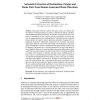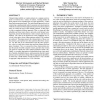KI
2008
Springer
13 years 4 months ago
2008
Springer
Abstract. Collective phenomena and their associated movement patterns are ubiquitous in everyday life. However, even though we need to be able to reason about these phenomena, espe...
GISCIENCE
2010
Springer
13 years 5 months ago
2010
Springer
Behavioral experiments addressing the conceptualization of geographic events are few and far between. Our research seeks to address this deficiency by developing an experimental fr...
GISCIENCE
2010
Springer
13 years 5 months ago
2010
Springer
Researchers from the cognitive and spatial sciences are studying text descriptions of movement patterns in order to examine how humans communicate and understand spatial informatio...
MOBICOM
2006
ACM
13 years 10 months ago
2006
ACM
Characterizing mobility or contact patterns in a campus environment is of interest for a variety of reasons. Existing studies of these patterns can be classified into two basic a...
MDM
2007
Springer
13 years 10 months ago
2007
Springer
Abstract—Dummy-based anonymization techniques for protecting location privacy of mobile users have been proposed in the literature. By generating dummies that move in humanlike t...
GIS
2007
ACM
13 years 10 months ago
2007
ACM
As technology advances we encounter more available data on moving objects, thus increasing our ability to mine spatiotemporal data. We can use this data for learning moving object...
AINA
2007
IEEE
13 years 10 months ago
2007
IEEE
This paper presents Geo-Linda, a physically distributed tuple space. Geo-Linda targets ubiquitous computing applications involving the detection of movement patterns of objects an...
COSIT
2009
Springer
13 years 11 months ago
2009
Springer
Movement patterns of individual entities at the geographic scale are becoming a prominent research focus in spatial sciences. One pertinent question is how cognitive and formal cha...


